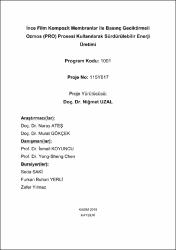| dc.contributor.author | Uzal, Nigmet | |
| dc.date.accessioned | 2024-03-19T12:53:38Z | |
| dc.date.available | 2024-03-19T12:53:38Z | |
| dc.date.issued | 2018 | en_US |
| dc.identifier.uri | https://hdl.handle.net/20.500.12573/2030 | |
| dc.description.abstract | Fosil yakıtlara bağımlılığın azalması için alternatif yenilenebilir ve temiz enerji kaynaklarının
bulunmasına yönelik araştırmalar gün geçtikçe artmakta ve önem kazanmaktadır. Son
yıllarda oldukça ilgi çeken “tuzluluk gradyanı esaslı ozmotik enerji” veya “mavi enerji” olarak
da bilinen enerji kaynağı, artan enerji ihtiyacını karşılamada farklı bir yenilenebilir kaynak
olarak ortaya çıkmıştır. Ülkemizdeki tuzluluk gradyanı esaslı enerji potansiyelinin
değerlendirilmesine yönelik ilk çalışma niteliğine olan bu projede öncelikle Devlet Su
İşlerinden (DSİ) elde edilen nehir debi ve tuzluluk değerleri esas alınarak teorik enerji
potansiyeli hesaplamaları gerçekleştirilmiştir. Teorik hesaplamalar tamamlandıktan sonra,
enerji potansiyelinin deneysel olarak belirlenmesi için sentetik ve gerçek su örnekleri
kullanılarak basınç geciktirmeli ozmos (PRO) prosesinde deneysel çalışmalar
gerçekleştirilmiştir. Bu amaçla dört farklı (BW30-LE, SW30-HR, AG, AC) ticari ince film
kompozit (TFC) ters osmos membran 3-(3,4-Dihydroxyphenyl)-L-alanine (L-DOPA) ve LDOPA ile birlikte nanomalzemeler (MWCNT, TiO2, SiO2, Al2O3) kullanılarak modifiye edilmiş
ve PRO sisteminde işletilerek enerji üretim performansı lab-ölçekli deneyler ile belirlenmiştir.
TFC yapıdaki RO membranların modifikasyonu sonrası aktif yüzeylerinde meydana gelen
yapısal değişiklerin belirlenmesinde SEM, FTIR, temas açısı, ve AFM analizleri
gerçekleştirilmiştir. Deney sonuçları ışığında L-DOPA ile birlikte %1wt TiO2 nanomalzeme ile
modifiye edilmiş BW30-LEmembranı 1,61 W/ m2 en yüksek PRO güç üretim potansiyelini
göstermiştir. Gerçek su örnekleri ile gerçekleştirilen PRO deneylerinde Akdeniz, Karadeniz,
Marmara ve Ege Denizlerinden deniz suyu ve bu denizlere dökülen Seyhan, Ceyhan, Büyük
Menderes, Gediz, Susurluk, Kızılırmak ve Yeşilırmak nehirlerinin karıştığı noktalardan
örnekler alınarak ülkemizde tuzluluk gradyanı esaslı bu enerjiye ilişkin potansiyel
belirlenmiştir. Geçek su numunelerinde en yüksek enerji üretim performansı 56,8 mS/cm
iletkenliğe sahip Akdeniz ile 586 µS/cm iletkenliğe sahip Ceyhan ve Seyhan nehrinin PRO
prosesi uygulamasından 5 ve 10 barda sırasıyla 0,47 ve 0,68 W/m2 olarak bulunmuştur. | en_US |
| dc.description.abstract | In order to decrease dependence on fossil fuels, researches on finding alternative renewable
and clean energy sources have been increasing and gaining importance. In recent years, the
energy source, also known as “salinity gradient based osmotic energy” or “blue energy”
which attracts quite attention, has emerged as a alternative renewable resource in meeting
the increasing energy need. In this project, which is the first study to evaluate the salinity
gradient based energy potential in our country, primarily theoretical energy potential
calculations have been made by taking the river flow and salinity values obtained from State
Hydraulic Works (DSI). After the theoretical calculations were completed, experimental
studies were carried out in the PRO process using synthetic and real water samples to
determine the experimentally energy potential. For this purpose, four different (BW30-LE,
SW30-HR, AG, AC) commercial thin film composite (TFC) reverse osmosis membranes have
been modified using nanomaterials with 3-(3,4-Dihydroxyphenyl)-L-alanine (L-DOPA) and LDOPA (MWCNT, TiO2, SiO2, Al2O3) and energy production by the pressure retarded osmosis
(PRO) system performance was determined by lab-scale experiments. SEM, FTIR, contact
angle, and AFM analyzes were performed to determine the structural changes in active
surfaces after modification of RO membranes in TFC character. According to the test results,
BW30-LE membrane modified with 1% wt TiO2 nanomaterial with L-DOPA showed the
highest PRO power generation potential of 1.61 W/m2
. In the PRO experiments carried out
with real water samples collected from the Mediterranean, Black Sea, Marmara and Aegean
Seas and the rivers poured into these seas, Seyhan, Ceyhan, Büyük Menderes, Gediz,
Susurluk, Kızılırmak and Yeşilırmak rivers, the potential for this energy based on salinity
gradient was determined. The highest energy production performances were observed as
0.47 and 0.68W/m2 in 5 and 10 bar, respectively, from application of PRO process of Ceyhan
ans Seyhan river having 586 µS/cm conductivity and Mediterranean, having 56.8 mS/cm
conductivity. | en_US |
| dc.language.iso | tur | en_US |
| dc.publisher | TUBİTAK | en_US |
| dc.rights | info:eu-repo/semantics/openAccess | en_US |
| dc.subject | Basınç geciktirmeli ozmoz | en_US |
| dc.subject | ince film kompozit membran | en_US |
| dc.subject | mavi enerji | en_US |
| dc.subject | tuzluluk gradyanı | en_US |
| dc.subject | yenilenebilir enerji. | en_US |
| dc.subject | Blue energy | en_US |
| dc.subject | pressure retarded osmosis | en_US |
| dc.subject | renewable energy | en_US |
| dc.subject | salintiy gradient | en_US |
| dc.subject | thin film composite membrane | en_US |
| dc.title | İnce Film Kompozit Membranlar ile Basınç Geciktirmeli Ozmos (PRO) Prosesi Kullanılarak Sürdürülebilir Enerji Üretimi | en_US |
| dc.title.alternative | measurements obtained in the project, and the parameters controlling the reaction rates in the model were estimated. Nitrification rates according to the estimations were cpmpared with the results of nitrification rates obtained by isotopic measurements. This comparison showed the potential of using modeling system and parameter estimation as an alternative approach to the hard isotope measurements for estimating reaction rates. One-year long observations, isotope methods used and modeling approach have made significant contributions to scientific knowledge in the region. Bacterial community structure have been revealed by culture-independent method for the first time in the coasts of Turkey. In addition, isotope methods and metatranscriptom study showed that nitrogen fixation is not a dominant process in the region. And a biogeochemical modeling system has been successfully adapted to the region. | en_US |
| dc.type | project | en_US |
| dc.contributor.department | AGÜ, Mühendislik Fakültesi, İnşaat Mühendisliği Bölümü | en_US |
| dc.contributor.authorID | 0000-0002-0912-3459 | en_US |
| dc.contributor.institutionauthor | Uzal, Nigmet | |
| dc.identifier.startpage | 1 | en_US |
| dc.identifier.endpage | 146 | en_US |
| dc.relation.journal | Tubitak | en_US |
| dc.relation.tubitak | 115Y617 | |
| dc.relation.publicationcategory | Diğer | en_US |


















